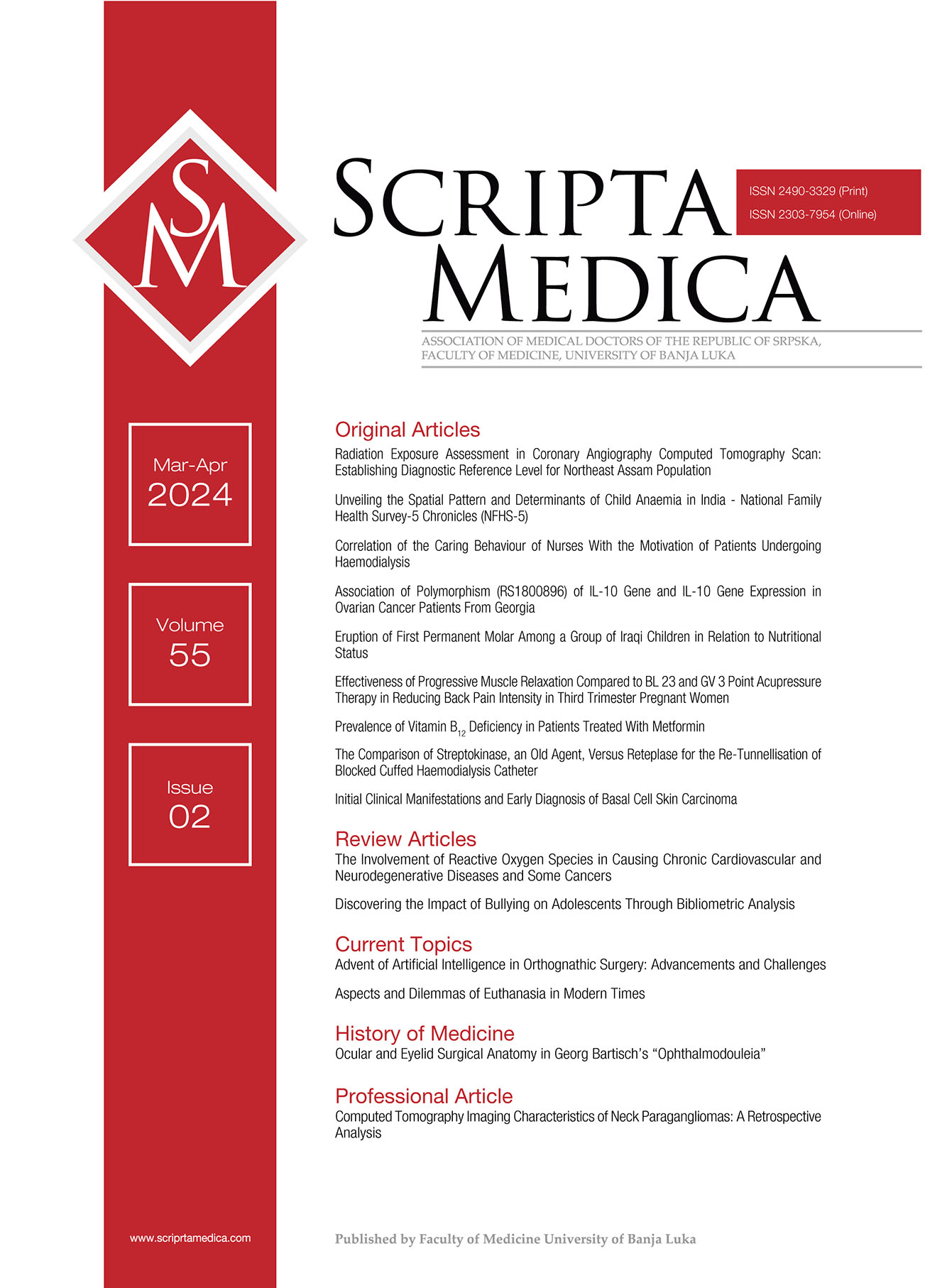The Comparison of Streptokinase, an Old Agent, Versus Reteplase for the Re-Tunnellisation of Blocked Cuffed Haemodialysis Catheter
Abstract
Background/Aim: Catheter occlusion is the most common complication occurring in patients with end-stage renal disease (ESRD) who undergo haemodialysis. The management typically involves the use of local fibrinolytic agents. However, with the emergence of novel agents, the use of older agents has declined. The purpose of the study was to compare the effectiveness of reteplase versus streptokinase (SK) in resolving haemodialysis catheter occlusion.
Methods: This randomised clinical trial involved 100 patients with catheter occlusion who were equally divided into two groups of 50. One group received treatment with reteplase, while the other group received treatment with SK. The occluded catheter in the first group was instilled with 250,000 units (U) of SK, while the second group received 2 U of reteplase and the catheters were left in place for 2-6 h. Successful flushing of the catheter with a velocity of ≥ 200 rounds per minute was considered successful re-tunnelling. The study also evaluated the frequencies of re-injections and drug-related adverse effects.
Results: The success rate of SK versus reteplase did not differ significantly (p = 0.48). However, the required time to inject the agents to achieve appropriate luminal patency was statistically higher in the reteplase-treated group (p = 0.018). None of the patients experienced major adverse effects such as bleeding or anaphylactic reactions.
Conclusion: According to the findings of this study, both reteplase and SK resulted in significant recovery of luminal patency with no adverse effects. However, the lower frequency of re-injections required with SK to achieve successful rationalisation favoured the use of this agent over reteplase. Further studies are strongly recommended.
References
Thomas M, Nesbitt C, Ghouri M, Hansrani M. Maintenance of hemodialysis vascular access and prevention of access dysfunction: a review. Ann Vasc Surg. 2017 Aug;43:318-27. doi: 10.1016/j.avsg.2017.02.014.
Gunawansa N, Sudusinghe DH, Wijayaratne DR. Hemodialysis catheter-related central venous thrombosis: clinical approach to evaluation and management. Ann Vasc Surg. 2018 Aug;51:298-305. doi: 10.1016/j.avsg.2018.02.033.
Selçuk E, Arıkan AA, Bayraktar FA. Outcomes of thrombolytic therapy of tunnelled hemodialysis catheter dysfunction. Vasc Endovascular Surg. 2021 Nov;55(8):811-6. doi: 10.1177/15385744211023292.
Huang Y, Yu L, Ren J, Gu B, Longstaff C, Hughes AD, et al. An activated-platelet-sensitive nanocarrier enables targeted delivery of tissue plasminogen activator for effective thrombolytic therapy. J Control Release. 2019 Apr 28;300:1-12. doi: 10.1016/j.jconrel.2019.02.033.
Wang Y, Sun X. Reevaluation of lock solutions for Central venous catheters in hemodialysis: a narrative review. Ren Fail. 2022 Dec;44(1):1501-18. doi: 10.1080/0886022X.2022.2118068.
Tahir T, Raja KM, Azam MN, Arshad AR, Mir AW. Comparison of streptokinase and urokinase for thrombolysis in blocked tunnel cuffed catheter among the patients of chronic renal failure undergoing hemodialysis. Pak Armed Forces Med J. 2022;72(3):792-5. doi: 10.51253/pafmj.v72i3.4112.
Roohvand F. Study break: streptokinase for treatment of thrombotic disorders: the end? Or the end of the beginning? Iran Biomed J. 2018 May 1;22(3):140-1. Epub 2017 Nov 14. PMID: 29132206.
Lucas TC, Haniel J, Huebner R. Numerical simulation of blood fluid in hemodialysis catheters and its thrombogenic potential. Acta Sci Health Sci. 2019;41:e45613-e. doi: 10.4025/actascihealthsci.v41i1.45613.
Castner D. The efficacy of reteplase in the treatment of thrombosed hemodialysis venous catheters. Nephrol Nurs J. 2001 Aug;28(4):403-4, 407-10. PMID: 12143462.
Falk A, Samson W, Uribarri J, Vassalotti JA. Efficacy of reteplase in poorly functioning hemodialysis catheters. Clin Nephrol. 2004 Jan;61(1):47-53. doi: 10.5414/cnp61047.
Hyman G, England M, Kibede S, Lee P, Willets G. The efficacy and safety of reteplase for thrombolysis of hemodialysis catheters at a community and academic regional medical center. Nephron Clin Pract. 2004;96(2):c39-42. doi: 10.1159/000076397.
Hilleman DE, Dunlay RW, Packard KA. Reteplase for dysfunctional hemodialysis catheter clearance. Pharmacotherapy. 2003 Feb;23(2):137-41. doi: 10.1592/phco.23.2.137.32086.
Hilleman D, Campbell J. Efficacy, safety, and cost of thrombolytic agents for the management of dysfunctional hemodialysis catheters: a systematic review. Pharmacotherapy. 2011 Oct;31(10):1031-40. doi: 10.1592/phco.31.10.1031.
da Costa ACC, Vieira NNP, Vasques CI, Ferreira EB, Guerra ENS, Dos Reis PED. Interventions for occluded central venous catheters: a meta-analysis. Pediatrics. 2019 Dec;144(6):e20183789. doi: 10.1542/peds.2018-3789.
Wahaj, Butt B, Azam N, Raja KM. To ascertain the efficacy, cost effectiveness of streptokinase as intraluminal thrombolytic for occluded tunneled catheters in dialysis patients of a tertiary care hospital-a single center experience. Pak Armed Forces Med J. 2020;70(1):174-9.
- Authors retain copyright and grant the journal right of first publication with the work simultaneously licensed under a Creative Commons Attribution License that allows others to share the work with an acknowledgement of the work's authorship and initial publication in this journal.
- Authors are able to enter into separate, additional contractual arrangements for the non-exclusive distribution of the journal's published version of the work (e.g., post it to an institutional repository or publish it in a book), with an acknowledgement of its initial publication in this journal.
- Authors are permitted and encouraged to post their work online (e.g., in institutional repositories or on their website) prior to and during the submission process, as it can lead to productive exchanges, as well as earlier and greater citation of published work (See The Effect of Open Access).

